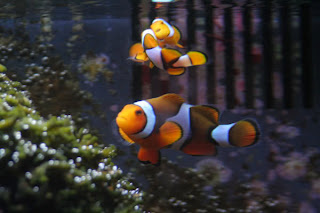Ocellaris clownfish are marine ornamental fish from
the most popular. Its tiny and striking colors and lively characters make this
much-loved fish as ornamental fish.

Clown fish live in symbiosis with anemones mutualism.
Mutualism Symbiosis means livings together between two living things are
mutually beneficial to each other. Sea anemones are plants that have poisonous tentacles.
This plant is a carnivorous (animal -eating) fish with a poison that paralyzes
the tentacles. Clown
fish anemone toxin can be overcome by making himself known not as an alien creature.
When you first occupy a toxic species of anemone fish clown will try to adjust
to the tentacles to follow the movements of the tentacles and then used to
touch the tentacles. Only a few species of anemones that will be occupy by the
clown fish. Clown fish anemone benefit from the form of food and protection
from predators that will not chase near anemones, while cleansing the body of
the anemone get food scraps and dead tentacles.

Ocellaris
clownfish live in the ocean floor where there are anemones. Sea anemones
are plants that have poisonous tentacles. Clown fish are common in warm waters
in the tropical Pacific Ocean, Red Sea, Indian Ocean and Great Barrier Reef of
Australia.
Ocellaris clownfish
feed from anemone leftovers. The wait anemone paralyzes fish and eats fish catches.
Clown fish will eat leftover food that is not consumed anemone. Clown fish also
eat the dead tentacles of anemones, algae and plankton.
In
a group of clown fish, there is a female predominance. There is only one stud (mating
eligible male fish) and one female in a group of clown fish. Other clown fish
is a male hermaphrodite, meaning that he could turn into females. If the female
clown fish die then one clown fish will be females. These
female clowns fish will then choose one of the clown fish into males have
mating rights.